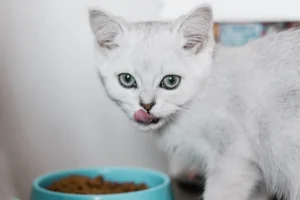Cats are known for their keen eyesight, but have you ever wondered why they can’t see the color red? The answer lies in their unique biological makeup.
Cats have a different type of vision compared to humans, which affects how they perceive certain colors. Here’s a breakdown of why cats can’t see red:
How Cat Vision Differs from Humans
Did you know that cats and humans see the world in very different ways? One major factor that contributes to this difference is the way our eyes perceive colors. While humans have three types of cones in our retinas, allowing us to see a wide range of colors, cats only have two types of cones. This means that cats are not able to see the color red as vividly as humans do.
The biological reason behind this limited color perception in cats lies in the specific cone cells found in their eyes. These cones are sensitive to different wavelengths of light, with one type being more attuned to short wavelengths (blue and green) and the other to medium wavelengths (yellow). As a result, cats can see blue and yellow hues more clearly, but red appears dull and muted to them.
The Role of Rods and Cones in Cat Vision
In addition to their two types of cones, cats also have rod cells in their retinas, which play a crucial role in their vision. Rods are highly sensitive to low light levels and are responsible for night vision in cats. However, rods are not sensitive to color, which further limits cats’ ability to see red.
The combination of rod cells for night vision and two types of cones for day vision gives cats a unique visual advantage in low light conditions. While cats may not be able to appreciate the color red like humans do, their adaptations in vision allow them to navigate the world efficiently both during the day and at night.
Insightful tip : Cats’ vision is optimized for hunting in dim light conditions, where the ability to see movement is more critical than distinguishing colors like red. This evolutionary adaptation has helped cats thrive as predators in a variety of environments.
Evolutionary Factors Influencing Cat Vision
Cats’ specialized vision has developed over evolution to enhance their hunting and survival skills. Their ancestors, wild cats, relied on keen eyesight to stalk prey efficiently. This evolution has shaped cats’ vision to prioritize detecting motion and contrast, rather than distinguishing colors like red. Cats have evolved to see best in low light conditions, allowing them to be more active during dusk and dawn when their prey is most active. This specialized vision is essential for their survival in the wild, where camouflage and stealth are crucial for successful hunting.
Can Cats See Any Shades of Red?
While cats cannot see the color red as vividly as humans, they are not completely blind to it. Cats’ vision is based on having two types of color receptors in their eyes, compared to the three types humans have. This limits cats’ ability to see the color red and other similar shades. Instead, cats perceive red as a shade of green. So, while red objects may appear dull or different to cats, they are not completely invisible. Cats primarily rely on other visual cues, such as movement and brightness contrast, to navigate their environment and hunt prey.
- Cats can see some shades of red: While not as vibrant as humans see it, cats can distinguish some shades of red from other colors in their environment. These shades may appear more muted or blend in with other colors, affecting how cats perceive them.
Remember, cats rely on various senses, like their keen sense of smell and sharp hearing, to compensate for their limited color vision. Their unique visual capabilities have evolved to suit their predatory instincts and thrive in their natural habitats.
The Benefits of Cats’ Unique Vision
Cats may not be able to see red, but don’t underestimate their specialized vision! This limitation actually enhances their hunting prowess. The lack of red vision allows cats to focus more on movement and contrast, making them excellent at detecting prey in low light conditions. Their eyes are packed with light-sensitive cells called rods, giving them exceptional night vision. So, while red may be a mystery to them, their unique vision still gives them an edge in the wild.
Understanding Cats’ Color Preferences
Though cats can’t see red, they have a penchant for certain colors. Cats are more likely to see blues and greens, which stand out to their vision. These colors are easily distinguishable for our feline friends, often catching their attention and sparking their curiosity. So, when choosing toys or accessories for your cat, opt for shades of blue or green to pique their interest and keep them engaged.
Other colors that cats are attracted to:
– Yellow
– White
– Purple
Why not consider incorporating these colors into your cat’s environment to stimulate their senses and keep them entertained? It’s a simple way to cater to their unique color preferences and make their surroundings more engaging.
How Cats Adapt to Their Limited Color Vision
Cats have a unique vision system that lacks the ability to see certain colors, such as red. But fear not, as our feline friends have clever ways to adapt to this limitation. Cats rely more on motion and brightness rather than color to navigate their surroundings effectively. This means they may not be able to distinguish a red toy from a green one, but they can easily spot movement, making them excellent hunters.
Additionally, cats have a keen sense of smell and hearing to compensate for their color blindness. Their superior night vision also helps them see well in low-light conditions, making them skilled nocturnal hunters. So next time your cat seems uninterested in that bright red toy, remember that they see the world a little differently than we do.
Fun Facts About Cat Vision
- Vertical Slit Pupils: Unlike humans with round pupils, cats have vertical slit pupils that can adjust quickly to changes in light, allowing them to see better in various lighting conditions.
- Limited Color Range: Cats perceive the world in shades of blue and green, making reds and oranges appear more muted or grayish to them.
- Snout Color Vision: While cats may struggle with reds, they have better color vision in their snouts, which helps them locate food or objects close to their faces.
- Spotting Movement: Cats’ vision is more attuned to detecting movements, which is why your cat may not be interested in stationary objects but pounce on anything that moves.
Keep in mind these quirks about cat vision to understand and appreciate how our furry companions experience the world around them.
Alex, a passionate animal lover, has experience in training and understanding animal behavior. As a proud pet parent to two dogs and three cats, he founded AnimalReport.net to share insights from animal experts and expand his knowledge of the animal kingdom.









